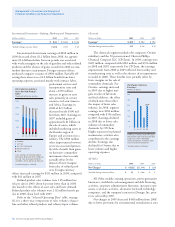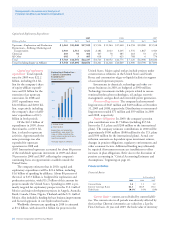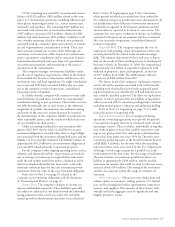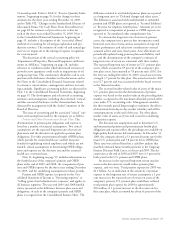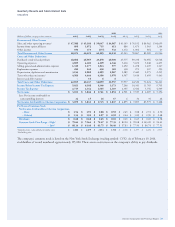Chevron 2009 Annual Report Download - page 28
Download and view the complete annual report
Please find page 28 of the 2009 Chevron annual report below. You can navigate through the pages in the report by either clicking on the pages listed below, or by using the keyword search tool below to find specific information within the annual report.
Management’s Discussion and Analysis of
Financial Condition and Results of Operations
26 Chevron Corporation 2009 Annual Report
FS-PB
The company and its affiliates also continue to review
and analyze their operations and may close, abandon, sell,
exchange, acquire or restructure assets to achieve operational
or strategic benefits and to improve competitiveness and prof-
itability. These activities, individually or together, may result
in gains or losses in future periods.
Environmental Matters
Virtually all aspects of the businesses in which the company
engages are subject to various federal, state and local envi-
ronmental, health and safety laws and regulations. These
regulatory requirements continue to increase in both number
and complexity over time and govern not only the manner
in which the company conducts its operations, but also the
products it sells. Most of the costs of complying with laws
and regulations pertaining to company operations and prod-
ucts are embedded in the normal costs of doing business.
Accidental leaks and spills requiring cleanup may occur
in the ordinary course of business. In addition to the costs
for environmental protection associated with its ongoing
operations and products, the company may incur expenses
for corrective actions at various owned and previously owned
facilities and at third-party-owned waste-disposal sites used
by the company. An obligation may arise when operations are
closed or sold or at non-Chevron sites where company products
have been handled or disposed of. Most of the expenditures to
fulfill these obligations relate to facilities and sites where past
operations followed practices and procedures that were con-
sidered acceptable at the time but now require investigative or
remedial work or both to meet current standards.
Using definitions and guidelines established by the
American Petroleum Institute, Chevron estimated its worldwide
environmental spending in 2009 at approximately $3.5 billion
for its consolidated companies. Included in these expenditures
were approximately $1.7 billion of environmental capital
expenditures and $1.8 billion of costs associated with the
prevention, control, abatement or elimination of hazardous
substances and pollutants from operating, closed or divested
sites, and the abandonment and restoration of sites.
For 2010, total worldwide environmental capital expen-
ditures are estimated at $2.1 billion. These capital costs are
in addition to the ongoing costs of complying with envi-
ronmental regulations and the costs to remediate previously
contaminated sites.
It is not possible to predict with certainty the amount
of additional investments in new or existing facilities or
amounts of incremental operating costs to be incurred in the
future to: prevent, control, reduce or eliminate releases of
hazardous materials into the environment; comply with exist-
ing and new environmental laws or regulations; or remediate
and restore areas damaged by prior releases of hazardous
materials. Although these costs may be significant to the
results of operations in any single period, the company does
not expect them to have a material effect on the company’s
liquidity or financial position.
Critical Accounting Estimates and Assumptions
Management makes many estimates and assumptions in
the application of generally accepted accounting principles
(GAAP) that may have a material impact on the company’s
consolidated financial statements and related disclosures
and on the comparability of such information over different
reporting periods. All such estimates and assumptions affect
reported amounts of assets, liabilities, revenues and expenses,
as well as disclosures of contingent assets and liabilities.
Estimates and assumptions are based on management’s expe-
rience and other information available prior to the issuance
of the financial statements. Materially different results can
occur as circumstances change and additional information
becomes known.
The discussion in this section of “critical” accounting
estimates and assumptions is according to the disclosure
guidelines of the Securities and Exchange Commission
(SEC), wherein:
1. the nature of the estimates and assumptions is mate-
rial due to the levels of subjectivity and judgment
necessary to account for highly uncertain matters
or the susceptibility of such matters to change; and
2. the impact of the estimates and assumptions on the
company’s financial condition or operating perfor-
mance is material.
Besides those meeting these “critical” criteria, the
company makes many other accounting estimates and
assumptions in preparing its financial statements and related
disclosures. Although not associated with “highly uncertain
matters,” these estimates and assumptions are also subject to
revision as circumstances warrant, and materially different
results may sometimes occur.
For example, the recording of deferred tax assets requires
an assessment under the accounting rules that the future
realization of the associated tax benefits be “more likely
than not.” Another example is the estimation of crude-oil
and natural-gas reserves under SEC rules, which, effective
December 31, 2009, require “…by analysis of geosciences
and engineering data, (the reserves) can be estimated with
reasonable certainty to be economically producible…under
existing economic conditions” where existing economic con-
ditions include prices based on the average price during the


